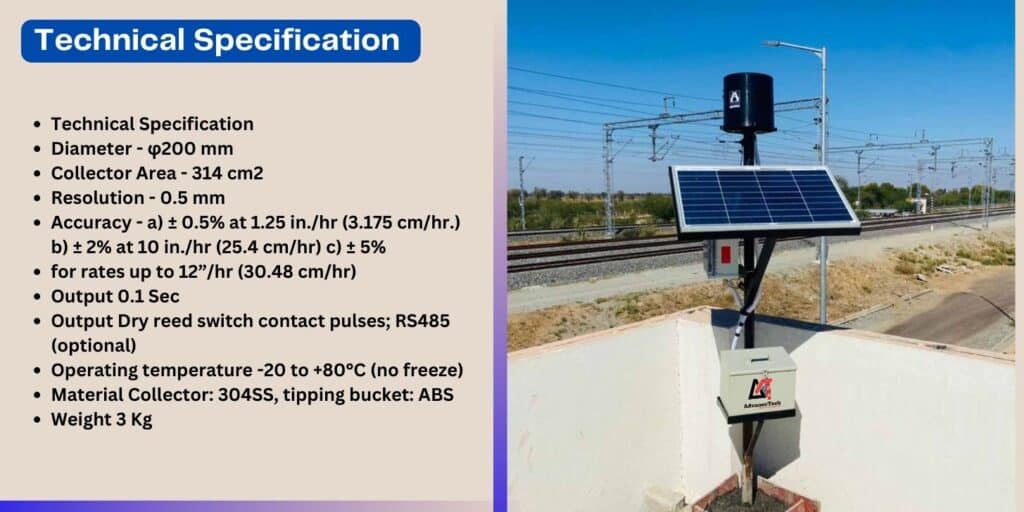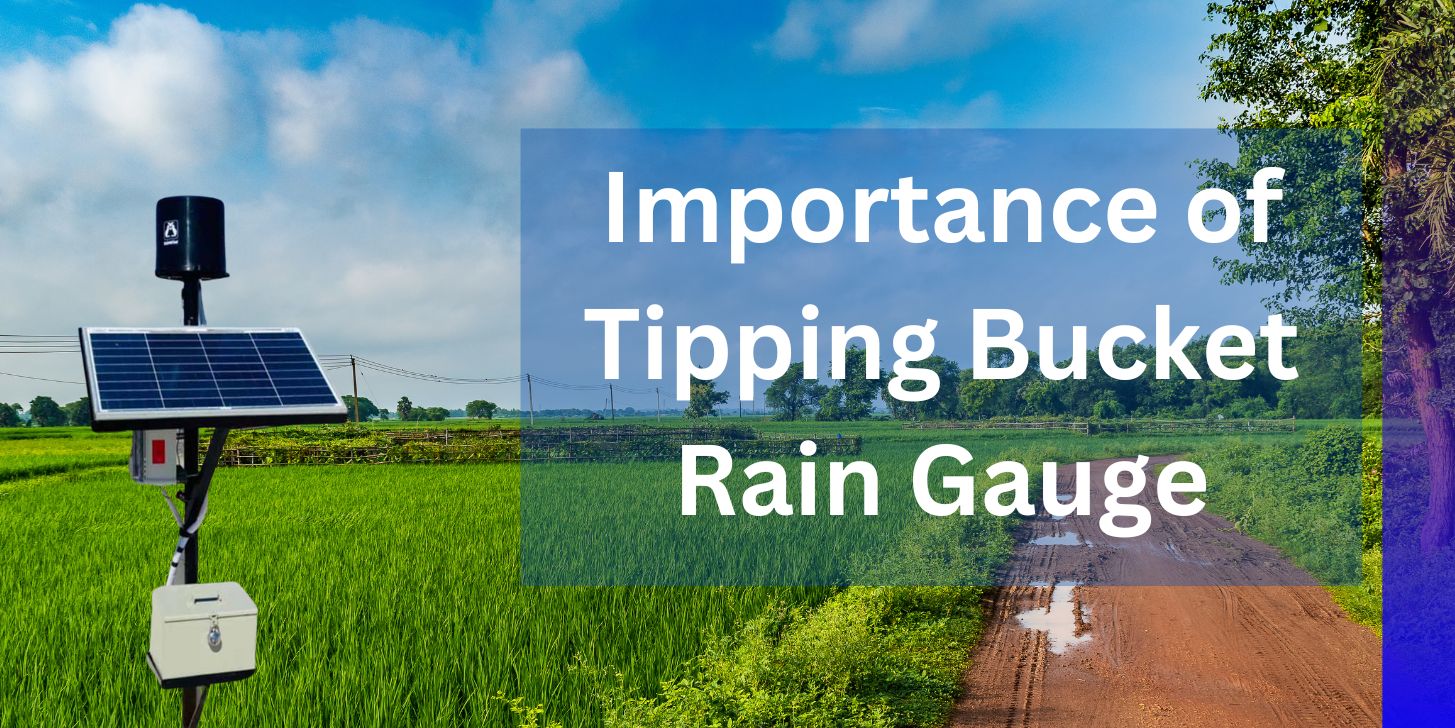Rain gauge is a device to measure liquid rainfall amount and intensity. The device is composed of a rain collector cone and a double-chamber tipping bucket connected to a magnet. In order to meet the requirement of information transmission, processing, recording and display, the amount of rainfall is converted to pulse output by the magnet. It can be widely used in weather stations, hydrometric stations, agriculture & forestry, defense & field monitoring stations. It can provide the original data for flood prevention, water-supply system, and reservoir water management in plant
Accurate rainfall measurement is crucial for a variety of sectors, from agriculture to urban planning. With a tipping bucket rain gauge (Automatic Weather Station) We can easily know exactly how much rain has fallen helps in forecasting weather, managing water resources, and preventing natural disasters like floods.
Table of Contents
ToggleAutomatic Rain Gauges: Precision at Its Best
The automatic rain gauge is one of the most reliable devices for measuring rainfall. An autonomous rain gauge, in contrast with traditional techniques, gathers data constantly and provides real-time updates—a crucial component of effective weather forecasting and climate research.
How It Works: The Tipping Bucket Rain Gauge
The tipping bucket rain gauge is a common kind of automatic rain gauge. The rainwater is directed into a small bucket by use of a funnel in this apparatus. The bucket tips when it reaches a preset level, draining the water and starting over to gather more. An accurate measurement of the rainfall is provided by the recording of each tip.
The Most Common Type Of Tipping Bucket Rain Gauge by Adr tech India comes with data logger:

The most common rain detector used in electronic weather stations is the “tipping bucket” type of rain sensor. This innovative technology features two small “buckets” mounted on a fulcrum, balanced like a see-saw. These buckets are precisely manufactured to hold an exact amount of precipitation, typically 0.01 inches. Positioned under the rain collector, the tipping bucket assembly funnels precipitation into the buckets.
As rainfall fills one bucket, it tips over, emptying itself while the other bucket pivots into place for the next measurement. Each tipping event triggers a small switch that activates the electronic circuitry, transmitting the count to the indoor console and recording the event as 0.01 inches of rainfall. For wireless rain gauges, this data is transmitted via a radio signal. Additionally, our tipping bucket type rain gauge comes equipped with a data logger, making it extremely useful for long-term data collection and analysis.
Features :
Features Compact size for easy use. High accuracy, good stability. Mesh in the funnel prevents debris such as leaves and insects from entering the working of rain sensors (mesh is optional). Highly polished stainless steel construction. Rain collector with filter, to prevent the leaves, such as debris jam over the hole. Optional heating function in cold region
Applications in Various Fields
Tipping bucket rain gauges are multipurpose instruments that are highly accurate in measuring rainfall in a variety of sectors. These are a few of their most important uses:
Agriculture
-
- For farmers to make well-informed decisions on irrigation, planting, and harvesting, accurate rainfall data is essential. Rain gauges with tippy buckets are useful for:
-
- Through strategic planning of irrigation, farmers can minimize water use and avoid over- or under-watering.
-
- Crop Protection: Farmers can predict and reduce any damage from heavy rains by keeping an eye on the amount of rainfall.
Urban Planning and Infrastructure
Rainfall measurement data is used by cities in the building and upkeep of infrastructure. Important uses are:
-
- Water Management: Planning efficient drainage systems to stop urban flooding requires accurate data.
-
- Rainfall data informs sewer system design and capacity, ensuring that the systems will endure high flow
Research and Education
Tipping bucket rain gauges are used by research and educational institutes for a range of investigations and instructional objectives.
-
- Field Studies: Automatic rain gauge are used by academics and students for practical instruction and field research.
-
- Data collection: To investigate weather patterns and hydrological cycles, researchers gather long-term data.
Environmental Monitoring
Tipping bucket rain gauges are used by environmental organizations to keep an eye on ecosystems and natural areas.
-
- Wetland Management: The management and preservation of wetland ecosystems depend heavily on rainfall data.
-
- Loss Control: Soil erosion can be predicted and controlled with the aid of an understanding of rainfall patterns.
Technical Specification

-
- Diameter – φ200 mm
-
- Collector Area – 314 cm2
-
- Resolution – 0.5 mm
-
- Accuracy – a) ± 0.5% at 1.25 in./hr (3.175 cm/hr.) b) ± 2% at 10 in./hr (25.4 cm/hr) c) ± 5%
-
- for rates up to 12”/hr (30.48 cm/hr)
-
- Output 0.1 Sec
-
- Output Dry reed switch contact pulses; RS485 (optional)
-
- Operating temperature -20 to +80°C (no freeze)
-
- Material Collector: 304SS, tipping bucket: ABS
-
- Weight 3 Kg
-
- Principle Switch close/open tipping bucket
-
- Design WMO Complied
-
- Leveling unit Bubble air fixed on the base
-
- Protection from dirtiness Removable filter on the in-let
-
- Protection rate IP66
Benefits of Using a Tipping bucket type rain gauge
Tipping bucket rain gauges offer numerous advantages, making them a preferred choice for accurate and reliable rainfall measurement. Here are some of the key benefits:
1. High Precision and Accuracy
-
- Consistent Measurement: Tipping bucket rain gauge made to precisely record data by measuring tiny amounts of rainfall, usually less than 0.01 inches.
-
- Minimal Human Error: Automated measurement reduces the potential for human error, leading to more reliable data.
2. Real-Time Data Collection
-
- Real-time updates are made possible by the tipping mechanism and are essential for prompt weather monitoring and forecasting.
-
- Remote Monitoring: A lot of tipping bucket rain gauge include wireless data transmission, making data collecting and monitoring possible from a distance..
3. Durability and Reliability
-
- Robust Design: These gauges are made to endure inclement weather, guaranteeing their lifetime and reliable operation.
-
- Low Maintenance: Compared to other kinds of rain gauges, the straightforward mechanical design requires less maintenance.
4. Versatility in Applications
-
- Agricultural Planning: Accurate rainfall data can be used by farmers to manage irrigation plans and safeguard crops against too much or too little water.
-
- Urban Infrastructure: To design efficient drainage systems and manage stormwater, city planners and engineers use rainfall data.
-
- Environmental Research: These gauges are used by scientists to examine the patterns of precipitation and its effects.
5. Cost-Effectiveness
-
- Affordable Technology: Compared to other sophisticated rainfall measurement devices, tipping bucket rain gauges offer a cost-effective solution without compromising accuracy.
-
- Efficiency: Automated data collection saves time and resources, reducing the need for manual monitoring.
Conclusion
Investing in an automatic rain gauge, such as a tipping bucket rain gauge, is essential for anyone serious about accurate rainfall measurement. These devices offer precise, real-time data, crucial for weather prediction, resource management, and environmental protection. Embracing technology in weather detection not only improves data accuracy but also enhances our ability to respond to and manage natural events effectively.
If you are also looking for best company, who provides best tipping bucket rain gauge, then you are at the right place, at www.adrtechindia.com you can find the best automatic rain gauge at very affordable prices with experts guidance.







